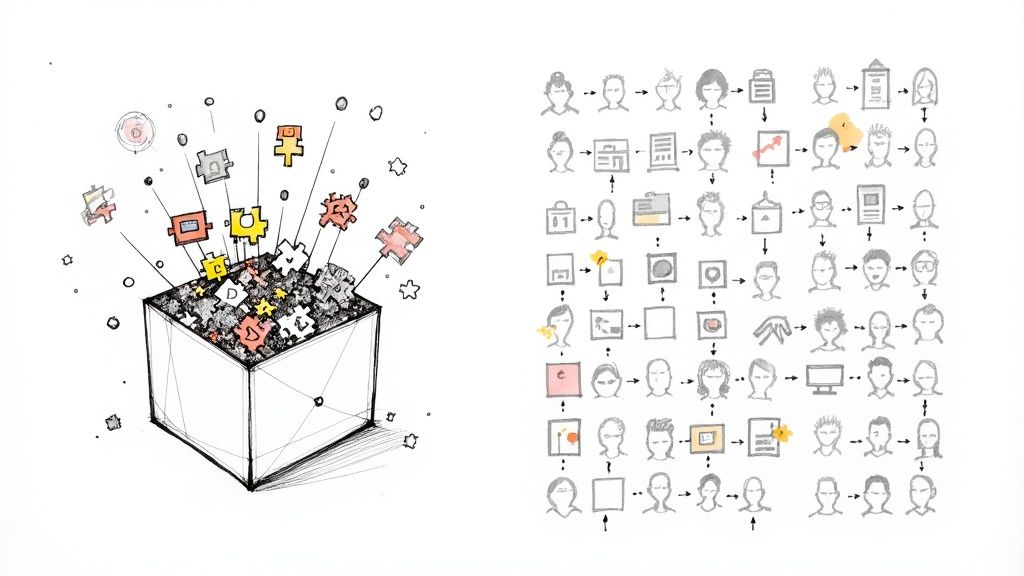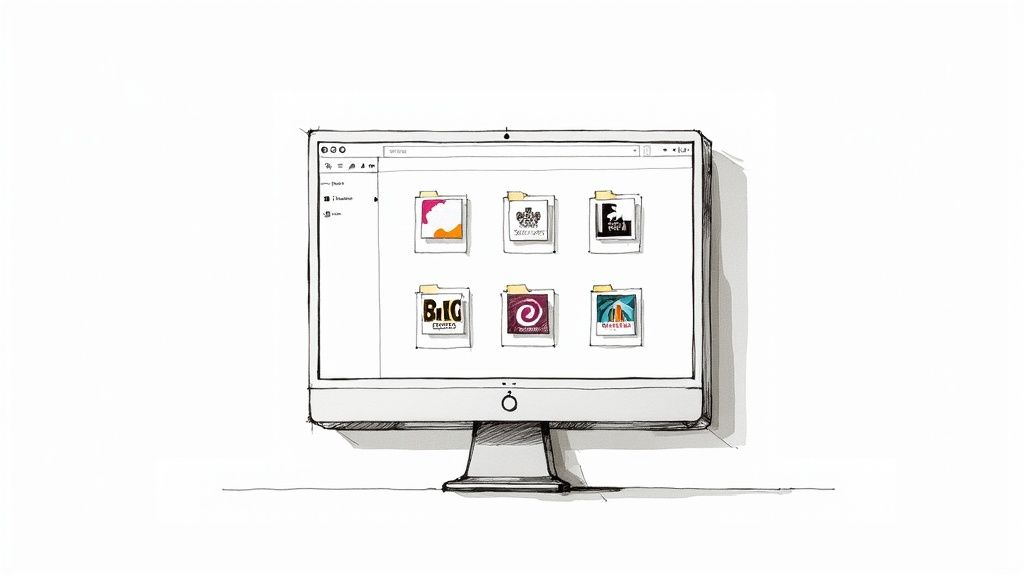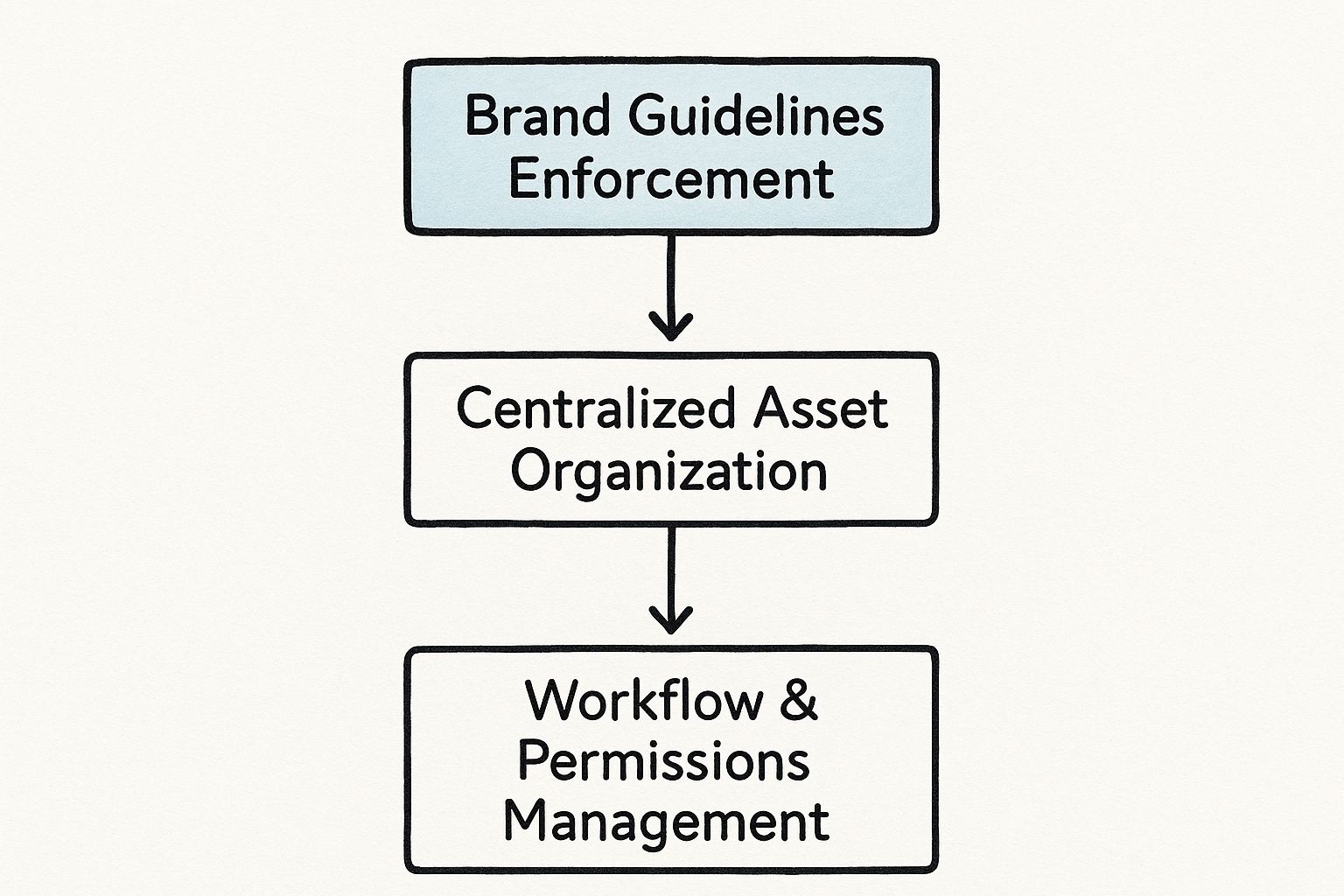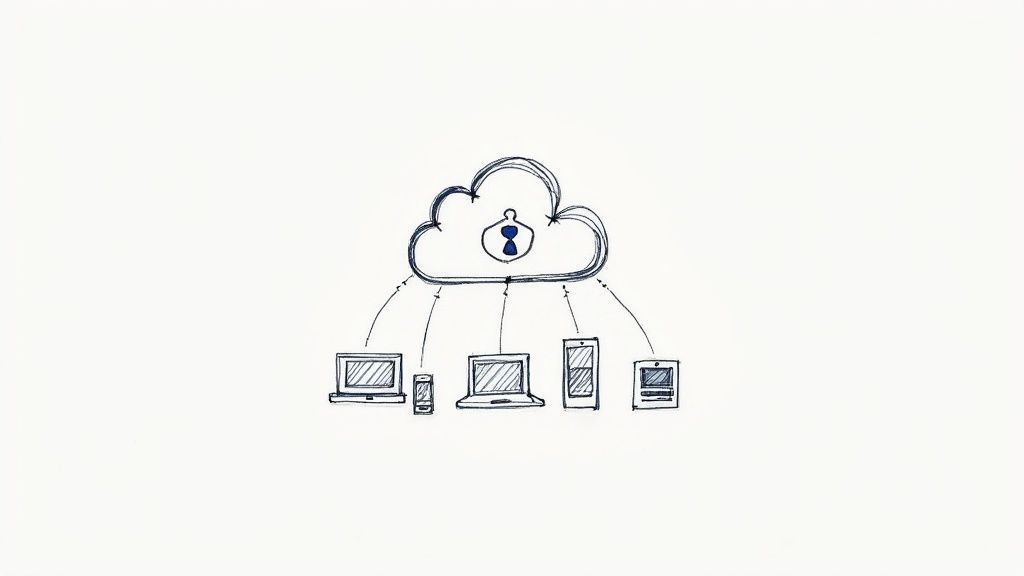Top Brand Asset Management Solutions for Your Business
Explore how brand asset management solutions enhance consistency and efficiency. Find out how to choose the right platform for your team.

Ever felt like you're on an endless scavenger hunt for the right logo, the latest presentation deck, or that one specific product photo? If that sounds familiar, you've experienced the digital chaos that plagues so many growing companies.
Brand asset management solutions are designed to be the antidote to that chaos. Think of them as a highly intelligent, central library for every single digital file that represents your brand. This isn't just about storage; it’s about creating an organized, controllable, and distributable hub for logos, videos, design templates, and everything in between. The goal is simple: ensure brand consistency and make everyone’s job easier.
What Exactly Are Brand Asset Management Solutions?

Picture trying to build a massive Lego set, but all the pieces are dumped in a dozen different bins, mixed with parts from other sets, and scattered across the house. That’s what managing brand files often feels like without a dedicated system. A brand asset management solution is the perfectly organized box, complete with instructions, where every piece has its place.
It’s a sophisticated digital library built specifically for your brand’s identity. This goes way beyond a shared drive or a Dropbox folder; it's a living, breathing ecosystem for your most critical creative files. It provides one single source of truth that everyone—from your internal marketing team and sales reps to external agencies and partners—can rely on.
The End of Digital Chaos
Without a proper system in place, it’s a fast track to digital disarray. Designers waste precious hours hunting for the latest file version, the sales team accidentally uses an old product slick, and a regional office launches a major campaign with an outdated logo. This isn't just inefficient; it actively erodes the consistency and integrity of your brand.
A brand asset management platform brings order to that mess. It essentially becomes the guardian of your brand, making sure every piece of content is:
- Current: No more guessing games. Everyone has access to the most up-to-date versions of every asset.
- Approved: Only finalized, legally cleared, and ready-to-use materials are available.
- On-Brand: Assets are packaged with clear guidelines, so everyone knows exactly how to use them correctly.
A strong brand asset management solution turns a frustrating hunt for a file into an instant, intuitive search. It gives your teams the confidence to move fast and create amazing work, knowing they’re always representing the brand perfectly.
This centralized control is the bedrock of operational sanity and powerful, consistent brand messaging.
More Than Just Storage
It's easy to confuse these platforms with simple cloud storage, but that’s a critical misunderstanding. While services like Google Drive are great for holding files, they just don't have the specialized tools needed for true brand governance.
Brand asset management solutions provide a complete framework for the entire lifecycle of a creative asset. For example, you can tag files with rich metadata, making them incredibly easy to find. Imagine needing to find every single logo variation that works on a dark background, or all product videos from the Q3 campaign, or every approved icon for a web project. A few clicks, and you're there.
Speaking of which, understanding the nuances of things like the proper use of icons is a perfect example of why this matters. These platforms can store the assets and the rules for using them, all in one place. At the end of the day, these systems are built from the ground up to take the guesswork and risk out of managing a modern brand.
What a Centralized Brand Hub Actually Does for Your Business

So, we know what a brand asset management solution is, but what's the real payoff? The true value isn't just about having tidy digital folders. It's about the tangible, day-to-day impact a central brand hub has on your business—influencing everything from brand strength to your team's speed and security.
The market is certainly taking notice. The global Brand Asset Management (BAM) software market is already valued at around $2 billion, but that's just the start. As more companies grapple with controlling their digital assets, experts predict the market will balloon to an estimated $6 billion within the next decade. You can dive deeper into the brand asset management market growth on datainsightsmarket.com. This isn't just a trend; it's a fundamental shift in how successful brands operate.
Finally Achieve Bulletproof Brand Consistency
Think about it: inconsistent branding is like a store changing its sign and logo every few weeks. It confuses customers and kills trust. A centralized hub becomes your company's single source of truth, making sure every single thing you put out there—from a quick social media post to a massive ad campaign—uses the right stuff.
We’ve all heard the horror stories. A regional team is about to launch a huge campaign, but someone grabs an old logo from their desktop. That one mistake can be embarrassing and expensive, derailing months of hard work. A proper brand asset management system makes this kind of slip-up practically impossible by ensuring everyone only has access to the latest, approved files.
Unlock Your Team's True Speed and Efficiency
For any creative or marketing team, time is gold. How much of it gets vaporized every single day? Designers hunt for the right image file, marketers chase down approvals, and salespeople can't find the one-pager they need for a client call.
A central brand hub ends the digital scavenger hunt. It gives teams back their most precious resource—time—so they can focus on what they were hired to do: create, strategize, and grow the business.
Imagine a sales rep on a critical call who needs a specific case study. Instead of firing off a frantic email to marketing and hoping for the best, they can use a smart search to find the exact, approved document in seconds. That kind of self-sufficiency lets your team move faster and with more confidence, which directly boosts productivity and, ultimately, revenue.
Safeguard Your Brand and Dodge Costly Risks
Protecting your brand is about more than just looking consistent; it's also about staying out of legal trouble. Using an image without the correct license or publishing a product claim that hasn't been vetted by legal can have serious financial and reputational consequences.
A solid brand asset management platform puts the right guardrails in place. Features like user permissions, version control, and asset expiration dates give you precise control over who can see, edit, and use your brand assets.
This means a well-meaning intern can't accidentally publish a draft logo, and a partner agency can't use a photo after its license has expired. This level of control turns your brand hub from a simple library into a powerful risk management tool, protecting your company's reputation and bottom line.
5 Essential Features of a Modern BAM Platform
When you're shopping for a brand asset management solution, it's easy to get lost in the marketing buzz. But not all platforms are built the same. To find one that will actually make a difference for your team, you need to look past the surface-level promises and focus on the core features that truly matter.
Think of it like buying a car. The sleek design and fancy paint job are nice, but what really counts is what's under the hood—the engine, the transmission, the safety features. For a BAM platform, powerful search capabilities and robust user permissions are the high-performance engine your brand needs to keep moving forward.
The image below breaks down how these core features work together, creating a stable structure that supports everything from high-level brand strategy to the day-to-day tasks your team handles.

As you can see, strong brand guidelines form the foundation, supported by organized assets, which are then managed through secure workflows and user controls. It’s a system where each part strengthens the others.
To help you evaluate your options, let’s dig into the five must-have features.
Essential Features of Modern Brand Asset Management Solutions
This table highlights the crucial features to look for in any BAM platform. It breaks down what each feature does and, more importantly, the direct benefit it brings to your organization's efficiency and brand consistency.
| Feature | Description | Core Benefit |
|---|---|---|
| Centralized Asset Library | A single, organized repository for all approved brand assets, from logos to videos and documents. | Consistency: Eliminates confusion and ensures everyone uses the latest, on-brand files. |
| Intelligent Search | Advanced search functionality powered by metadata, tags, and filters, not just filenames. | Speed: Drastically reduces the time spent searching for files, boosting team productivity. |
| Granular User Permissions | The ability to set specific access levels for different users and teams (e.g., view, download, edit). | Security: Protects sensitive assets and prevents unauthorized use or modification. |
| Automated Version Control | Automatically tracks revisions and archives old files, ensuring only the current version is visible. | Accuracy: Prevents costly mistakes from using outdated logos, messaging, or designs. |
| Brand Guidelines & Templates | A dedicated space to house brand guidelines and provide access to pre-approved, editable templates. | Compliance: Empowers teams to create on-brand materials independently, without constant oversight. |
By prioritizing these features, you ensure you’re investing in a solution that solves real problems instead of just a glorified file storage system.
1. A Single Source of Truth Asset Library
The absolute foundation of any good BAM is a centralized asset library. This becomes the one and only place your team goes for every approved brand file—logos, photos, videos, sales decks, you name it. It puts an end to the chaotic and risky habit of people pulling assets from their personal hard drives or some forgotten shared folder.
A unified library guarantees that everyone, every single time, is using the most current and on-brand materials. It’s where you can store and categorize every file, including the many different visual formats needed for modern design. To get a better handle on this, our detailed guide on file type icons is a great resource for understanding their specific uses.
2. Intelligent Search Powered by Metadata
How much time does your team waste just looking for a file? A modern BAM crushes this massive productivity drain with an intelligent search function fueled by metadata. Instead of just searching by a vague filename, users can pinpoint assets based on specific, descriptive tags and criteria.
Imagine you need every product shot from the "Q4 Holiday Campaign" that features a "red background" and is "approved for social media." With proper metadata, that search takes seconds, not an afternoon of digging.
A powerful search function does more than just find files. It gives your team the confidence and speed to execute campaigns without hesitation, knowing the perfect asset is always right at their fingertips.
3. Granular User Permissions and Controls
You wouldn’t hand over the keys to the CEO's office to everyone in the company. In the same way, not everyone on your team needs access to every single brand asset. Granular user permissions are essential for controlling exactly who can view, download, edit, and share specific files or folders.
This critical feature is all about control and safety. It ensures:
- Security: Sensitive materials for an upcoming campaign launch remain confidential.
- Compliance: Outside partners or agencies get access only to the assets they need for a specific project.
- Brand Integrity: It prevents untrained users from accidentally modifying or misusing master brand files.
4. Automated Version Control
One of the biggest threats to brand consistency is the accidental use of an old file. Automated version control completely solves this problem. The system keeps a full history of an asset's revisions while making sure that only the most recent, approved version is the one everyone sees and downloads.
When a logo gets an update, the old one is automatically archived. This simple action prevents it from ever showing up on new marketing materials again, creating a foolproof system that protects your brand’s identity and helps you avoid embarrassing (and costly) mistakes.
How to Choose the Right BAM Solution for Your Team
Picking a brand asset management solution isn’t like grabbing a piece of software off a shelf. It’s a real investment in your brand’s future. The "best" platform is never a one-size-fits-all answer; it’s the one that clicks perfectly with your team’s workflow, fixes your specific headaches, and can grow with you.
Making the right choice turns what feels like a daunting purchase into a confident, strategic decision. This means moving beyond a simple feature checklist and really digging into what your organization needs at its core. If you follow a clear framework, you'll end up with a partner, not just another product.
Audit Your Current Asset Chaos
Before you can find the right solution, you have to get painfully honest about the problem. Start by taking a hard look at your current "system"—even if that system is a chaotic mess of shared drives, random email chains, and forgotten folders.
Ask your team the tough questions to find the biggest pain points:
- How much time are designers and marketers really spending each week just looking for files?
- How often are we seeing outdated logos or incorrect images pop up in our marketing?
- What’s our process for sharing files with partners, and where are the frustrating bottlenecks?
This first step gives you a data-backed case for making a change and a concrete list of problems your new brand asset management solution absolutely must solve.
Choosing the right BAM platform is less about finding the one with the most features and more about finding the one that solves your most expensive problems—whether those costs are measured in wasted hours, brand inconsistencies, or missed opportunities.
Define Your Goals and Success Metrics
Once you've identified the problems, it's time to picture what success actually looks like. Vague goals like "be more efficient" just won't cut it. You need to get specific. Are you aiming to cut campaign launch times by 25%? Or maybe the goal is to completely stamp out incorrect logo usage within six months.
Your goals should be measurable and tied directly to real business outcomes. This clarity doesn't just guide your selection process; it also makes it a whole lot easier to prove the platform’s ROI to leadership later on.
Evaluate Key Integrations and Scalability
A BAM platform can't live on an island. It has to connect smoothly with the tools your team relies on every single day. Make a list of your must-have software, like Adobe Creative Cloud, project management tools such as Asana or Trello, and your website's content management system.
For teams that live and breathe design, integration with the right creative software is a non-negotiable. You can learn more about these in our guide covering the best vector design software available. A system that forces people to constantly jump between apps will just add friction back into the process you're trying to fix.
Scalability is just as critical. The platform you choose today has to support your brand's growth tomorrow. That could mean adding more users, handling a massive influx of new assets, or expanding into different regions. The wider Brand Management Software market is projected to hit $1.21 billion by 2030, which shows just how vital these scalable systems are becoming for growing businesses. You can find more brand management software growth insights on 360iresearch.com.
A Practical Plan for a Successful BAM Implementation

Picking the right brand asset management solution is just the first step. The real win comes from a smart, well-executed implementation. If you just dump all your files into a new system without a plan, you’ll end up with the same old mess in a shiny new package. A thoughtful, phased rollout is the key to getting your team on board and making the investment pay off.
Your first move should be a careful migration. This isn't just about dragging and dropping files. It’s the perfect opportunity to clean house. Audit everything you have, archive what’s old and irrelevant, and make sure only your best, approved assets make it into the new system.
Building Your Foundation with Structure and Metadata
Before a single file gets uploaded, you need to map out your digital library. This means defining a folder structure that makes sense to everyone and creating a metadata strategy that will make searching a breeze. Get this right, and you'll build a system that people actually want to use.
Think of your metadata tags as the secret weapon. They are the bits of information that help people find exactly what they need, right when they need it. Essential tags often include things like:
- Campaign Name: (e.g., "Q4 Holiday Launch 2024")
- Asset Type: (e.g., "Logo," "Product Shot," "Video Ad")
- Usage Rights: (e.g., "Internal Use Only," "Social Media Approved")
- Creation Date and Expiration Date: Crucial for keeping everything fresh and legally compliant.
A well-planned structure turns your platform from a simple storage locker into an intelligent, searchable database. It’s the difference between a cluttered attic and a perfectly organized library where every book is right where it should be.
This kind of upfront planning is what separates successful systems from failed ones. It's why the broader Media Asset Management (MAM) market, currently valued around $2.4 billion, is projected to explode to $10.1 billion by 2035. As you can find in reports on the expanding MAM market on futuremarketinsights.com, the value of organized digital assets is only going up.
Securing Buy-In and Driving Adoption
Once your digital foundation is set, it's time to focus on the people who will be using it. You need to get buy-in from key players across the company. Show them how this new tool will solve their real-world problems—whether that’s helping marketing launch campaigns faster or giving the sales team instant access to the latest pitch decks.
Finally, training is non-negotiable. But don't just give a boring tour of the features. Frame the sessions around tangible benefits. Show your teams exactly how the platform will make their day-to-day work easier. When people see it as an upgrade that helps them do their job better, they’ll be excited to jump in and start using it.
Common Questions About Brand Asset Management
Even after seeing all the benefits and features laid out, it's natural to have a few practical questions when your team gets serious about bringing in a brand asset management solution. Let's tackle the most common ones we hear. The goal here is to clear up any final uncertainties so you can move forward with confidence.
These are the real-world questions that come up time and again, covering everything from budget and timing to how these platforms are any different from the tools you’re already using.
Is This Just a Fancier Google Drive or Dropbox?
This is easily the most common question, and the answer gets to the very heart of what these platforms do. While tools like Google Drive or Dropbox are fantastic for basic file storage and sharing, a brand asset management system is something else entirely. It's a purpose-built platform designed to actively manage and protect your brand.
Think of it like this: cloud storage is a digital garage where you can dump all your stuff. A BAM platform is more like a high-tech workshop, with every tool in its place, clear instructions on how to use it, and a system for keeping everything in perfect working order.
A simple storage tool is passive. A BAM platform is an active guardian of your brand, offering powerful features you just won't find in a basic cloud drive:
- Smarter Searching: Forget trying to guess file names. You can search for assets by campaign, color palette, usage rights, or product line. The system knows what the asset is, not just what it's called.
- Automatic Version Control: This feature is a lifesaver. It ensures only the latest, approved version of any asset is available, putting an end to outdated logos or old campaign images slipping into the wild.
- Precision Access Control: You get to decide exactly who can see, download, or edit specific assets. This is critical for protecting sensitive materials or works-in-progress.
- Built-in Brand Guidelines: Your brand's rules aren't in a forgotten PDF somewhere. They’re integrated directly into the platform, guiding users on how to apply every asset correctly.
What Does This Actually Cost?
Most modern brand asset management solutions are sold as Software as a Service (SaaS). That means you'll pay a predictable monthly or annual subscription fee instead of a massive one-time cost upfront.
This subscription fee is usually calculated based on a few key things:
- Number of Users: How many people on your team need to get into the system?
- Storage Space: How large is your library of digital assets?
- Feature Level: Do you need advanced capabilities, like custom integrations with other software or API access for your developers?
The good news is that most providers offer tiered plans. This is perfect for growing businesses because you can start with a package that fits your current needs and budget, then scale up as your team grows and your asset library expands. It’s important to see this not just as a cost, but as an investment that pays for itself by saving countless hours and preventing expensive brand mistakes.
How Long Until We See a Return on Investment?
You won’t be waiting long. The return on investment (ROI) from a brand asset management platform shows up in both immediate wins and long-term value.
Teams often feel the impact right away, sometimes within the first few months. The sheer amount of time your creatives and marketers save—no more endless searching for files—frees them up for strategic work that actually moves the needle.
That immediate boost in productivity is your short-term gain.
The long-term ROI is where the real power lies. It comes from building iron-clad brand consistency, which is the bedrock of customer trust and brand value. A BAM platform also acts as a safety net, helping you avoid costly legal troubles over improper asset usage or the kind of embarrassing rebranding blunders that can damage your reputation. Most companies find that the combination of day-to-day efficiency and stronger brand governance delivers a clear, positive return well within the first year.
Ready to stop searching and start creating? With VibeIcons, you can generate high-quality, AI-powered icons that perfectly match your brand's style in seconds. Try it for free and see how easy it is to complete your icon sets. Get started with VibeIcons today!